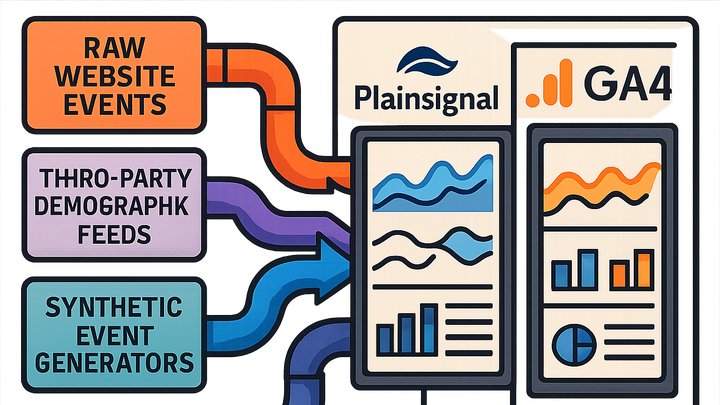Published on 2025-06-26T04:17:14Z
What is Data Augmentation in Analytics? Examples & Use Cases
Data augmentation in analytics refers to the process of enriching or expanding existing data sets by incorporating additional, external, or synthetic data. It helps fill gaps, improve model training, address privacy constraints (e.g., cookie deprecation), and deliver deeper insights. In practice, augmentation can involve appending demographic attributes from third-party sources, generating synthetic user events to balance datasets, or injecting server-side identifiers via cookie-free solutions like PlainSignal. When combined with platforms such as Google Analytics 4 (GA4), augmented data streams enable richer dashboards, more accurate attribution modeling, and robust machine learning applications. This entry covers why augmentation matters, key use cases, and step-by-step integration with PlainSignal and GA4.
Data augmentation
Enriching analytics data with external or synthetic information to improve completeness, accuracy, and insights.
Why Data Augmentation Matters
Raw analytics data often lacks full context due to privacy restrictions, sampling limits, or missing attributes. Data augmentation addresses these gaps to provide a more complete, accurate, and actionable view of user behavior.
-
Enhancing data completeness
Fill in missing user attributes or sessions blocked by cookie restrictions, ensuring a comprehensive dataset for analysis.
-
Improving model accuracy
Machine learning models benefit from richer feature sets, leading to better predictions, segmentation, and personalization.
-
Overcoming privacy constraints
Cookie-free augmentation approaches, like PlainSignal’s server-side identifiers, maintain tracking continuity without relying on browser cookies.
Key Use Cases
Data augmentation applies across various analytics scenarios, from enhancing event streams to improving attribution and personalization.
-
Cookie-free tracking enhancement
PlainSignal’s cookie-free technology injects server-side enriched identifiers to maintain session continuity in environments where cookies are restricted.
-
Synthetic event generation
Generate plausible user events to balance data distributions or simulate behaviors for testing analytics pipelines and training models.
-
User profile enrichment
Append demographic or behavioral attributes from third-party databases to user profiles for deeper segmentation and targeted marketing.
-
Cross-channel attribution
Augment analytics streams with offline sales or ad platform data to achieve more accurate multi-touch attribution across channels.
Implementing Data Augmentation with PlainSignal and GA4
Follow these steps to set up cookie-free enrichment via PlainSignal and transmit augmented hits to Google Analytics 4 for analysis.
-
Integrate PlainSignal code
Add the PlainSignal snippet to your website to start collecting cookie-free enriched data:
-
Code snippet
<link rel="preconnect" href="//eu.plainsignal.com/" crossorigin /> <script defer data-do="yourwebsitedomain.com" data-id="0GQV1xmtzQQ" data-api="//eu.plainsignal.com" src="//cdn.plainsignal.com/plainsignal-min.js"></script>
-
-
Configure GA4 augmentation
Use GA4’s Measurement Protocol and custom dimensions to transmit enriched data:
-
Measurement protocol
Send server-side hits enriched with PlainSignal identifiers and custom parameters (e.g., user_segment) directly to your GA4 property.
-
Best Practices and Considerations
Ensure your augmentation strategy remains effective, compliant, and maintainable as data volumes grow and regulations evolve.
-
Maintain data quality
Regularly validate augmented data streams to detect anomalies, duplicates, or skewed distributions before analysis.
-
Respect privacy regulations
Comply with GDPR, CCPA, and other laws by using privacy-preserving augmentation methods and maintaining clear consent records.
-
Document augmentation logic
Keep thorough documentation of data sources, transformation rules, and integration steps for transparency and troubleshooting.
